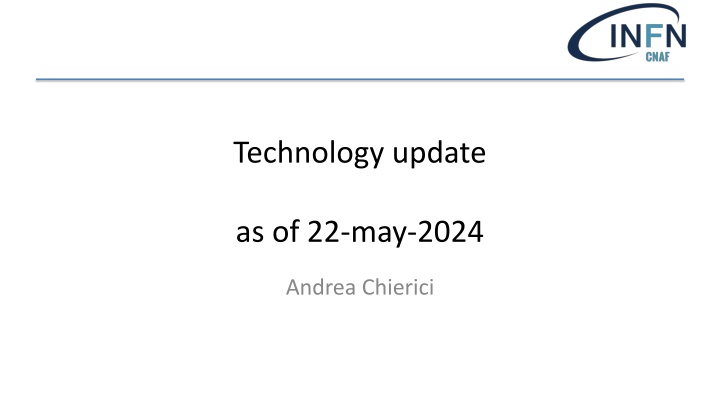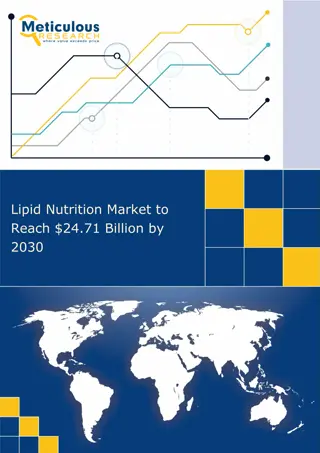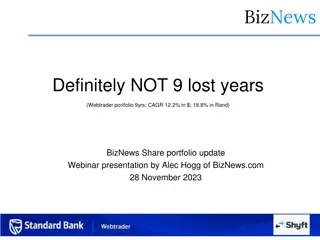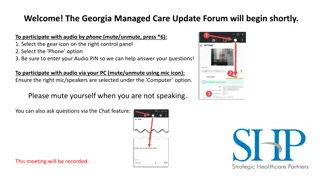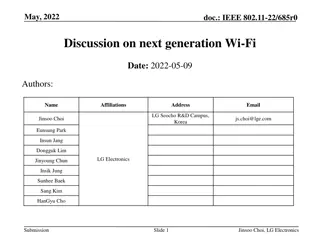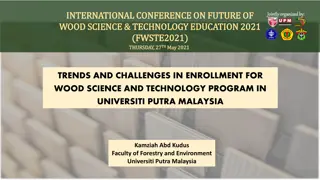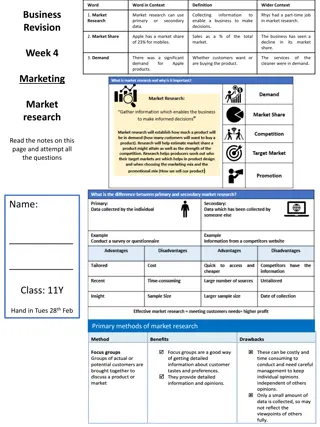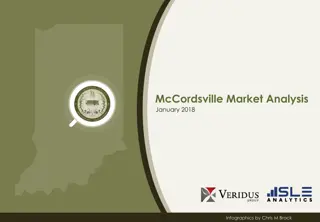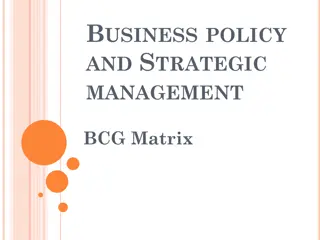Technology Update and Market Trends Overview
Explore the latest advancements in technology update, general market trends, major players in the data center industry, future fabrication processes, server market shifts towards AI and cloud, the rise of liquid cooling, CPU developments, and trends in CPUs with increasing core counts and new architectures until 2036.
Download Presentation

Please find below an Image/Link to download the presentation.
The content on the website is provided AS IS for your information and personal use only. It may not be sold, licensed, or shared on other websites without obtaining consent from the author.If you encounter any issues during the download, it is possible that the publisher has removed the file from their server.
You are allowed to download the files provided on this website for personal or commercial use, subject to the condition that they are used lawfully. All files are the property of their respective owners.
The content on the website is provided AS IS for your information and personal use only. It may not be sold, licensed, or shared on other websites without obtaining consent from the author.
E N D
Presentation Transcript
Technology update as of 22-may-2024 Andrea Chierici
Major Players Relative size of data center operators and equipment providers based on revenue estimates Guess who the green line is 3
Trends for fabrication processes Roadmap until 2036 Sub-1nm process nodes Transition from FinFET transistors to Gate All Around nanosheet designs CMOS 2.0 Smaller nodes are more expensive Breaking down chips into functional units using 3D designs helps bringing down costs Only three makers for leading edge chips - TSMC, Samsung, Intel Huge investments planned on fabs in diversified regions 4
Server market Server shipments stagnant, all growth is in AI and long-term shift to cloud ARM servers in the data center still very scarce but growing AMD also gaining ground 5
Liquid cooling to become mainstream Current generation 1U systems need heat pipes with big radiators to cool down 400W+ CPUs in this form factor Expecting for CPUs that 1U systems will become rare and 2U or even bigger will become the standard There is still no standard for liquid cooling and will probably take a few years for one to emerge next generation 6
Trends in CPUs Up to 128 cores today, 200+ announced TDP to reach 1 kW/socket in two generations Segmentation in CPU product lines HPC (higher frequency) Intel Granite Rapids (120 p-cores) AMD Genoa (Zen 4, 96c) Cloud (more cores) Intel Sierra Forest (288 e-cores) AMD Bergamo (Zen 4c, 128c) ARM resurgence Ampere Altra (128c) / Ampere One (192c) NVidia Grace CPU Superchip (144c) Amazon Graviton 4 Microsoft Cobalt 100 Single package GPU/CPU systems ( APUs ) AMD Mi300A, Nvidia Grace Hopper In-package memory AMD 3D V-Cache (SRAM on die) Intel Xeon Max (HBM2e DRAM) Nvidia Grace (LPDDR5X DRAM) 8
Intel Xeon 6 Same name, same motherboard different architectures GNR-AP/SP (P-cores) SRF-AP/SP (E-cores) no hyperthreading TDP up to 500W 9
Trends in accelerators GPU accelerators and related technology Nvidia H200 released in 2023 and Blackwell in 2024 AMD MI300X released in 2023 Intel Data Center Max in 2023 Major announcements expected in Q3 Broadcom announces support for AMD Infinity Fabric in its next-gen PCIe switch chips To connect more AMD GPUs, like NVSwitch for Nvidia GPUs AI Accelerators Captive processors from Amazon (Trainium2), Google (TPU v5) and Microsoft (Maia 100) Intel Gaudi2 (and Gaudi3), SambaNova SN40L 10
Google Axion In-house developed datacenter CPU Based on ARM Neoverse v2 DDR5 memory Google claims up to 50% higher performance and... up to 60% better energy efficiency compared to current-generation x86-based processors 30% higher performance compared to competing Arm-based CPUs for datacenters 11
Logic and memory All major logic foundries (TSMC/Samsung/Intel) now have EUV in production Intel last with Intel 4 Next transition is High NA EUV or multi pattern EUV Advanced packaging increasingly important Chiplets/die connectivity Power delivery and cooling DRAM memory CPU s transitioning from DDR4 to DDR5 memory (up to 8400?) DDR6 in 2026 HBM3 introduced in 2022. Higher bandwidth HBM3e products introduced in 2023 All major manufacturers except Micron have transitioned to EUV DRAM market recovering from collapse in late 2022/early 2023 12
Digression on EDSFF E3 form factors The E3 family of devices currently consists of four different form factors that are defined by a group of SNIA SFF specifications. The SNIA SFF specifications that define the E3 family include 13
Compute Express Link (CXL) Emerging open standard for high-bandwidth heterogeneous, disaggregated computing Unified, coherent memory space across CPUs & devices Resource sharing. Shared & fabric-attached memory pools PCIe Gen 5 physical layer Improved data & operand movement between hosts, accelerators Dynamic multiplexing of 3 protocols: CXL.io: traditional PCIe block I/O CXL.mem: device memory CXL.cache: system memory 14
Considerations Die size in CPUs/GPUs keeps growing leading to increased use of chiplet technology with ultrafast interconnects Manufacturers creating more specialized devices for domain specific applications, especially w/ AI specific designs Increasing proximity of GPU to CPU w/ high speed unified memory architectures 15
Some headlines SK Hynix and TSMC Team up for HBM4 Development SK Hynix Reports That 2025 HBM Memory Supply Has Nearly Sold Out AMD Zen 5 Status Report: EPYC Turin Is Sampling, Silicon Looking Great ASML Patterns First Wafer Using High-NA EUV Tool, Ships Second High-NA Scanner Samsung To Receive $6.4 Billion Under CHIPS Act to Build $40 Billion Fab in Texas 16
HDD Storage HAMR drives have finally arrived Seagate Mosaic 3+ 30TB HAMR drives shipping in Q1 2024, will eventually be adopted by a wide range of products Longer timescales for other players? Latest WD CMR drive is 22TB SMR drives give a 20% capacity increase over PMR ~50% of exabytes shipped by Western Digital are SMR drives Majority of exabytes shipped and revenue are nearline HDD Market was down for 2023 But expected to increase by 22% (Gartner) Still, cost/GB gap with SSD destined to decrease in the long term Nearline drives will be the last HDD holdout 18
Flash Storage SSD account for ~12% of enterprise storage capacity Samsung and SK Hynix dominate Western Digital spinning off flash business PCIe Gen 5 SSDs now available ~200+ Layer 3D NAND flash chips from all five major vendors ~1000 layers by 2030? Viability of penta-level cells unclear Exponentially more challenging to add more bits per cell Total revenues recovering from dip in late 2022/early 2023 19
Archive Storage Magnetic Tape Still a lot of room for scaling (unlike HDD) Strategy change at IBM for enterprise drives TS1170 - 50TB / cartridge. No backward compatibility IBM Diamondback library in a rack targets cloud hyperscale and traditional enterprises Total LTO cartridges shipped has been declining, but total exabytes shipped is flat Optical disk dead Panasonic and Sony discontinued Archival Disc drives and libraries On the horizon Cerabyte ceramic nano-memory Data etched in material via laser or particle beam Folio Photonics - No news since 2022 20
Network technology Transition to 400GbE (4x100Gbs) in progress 800GbE (8x100Gbs) specification released in 2020 Cloud adoption of higher bandwidth Ethernet outpaces rate in the enterprise Ultra Ethernet Consortium formed to make Ethernet more competitive with Infiniband for AI workloads Co-packaged optics in the works Reduce power consumption 22
WAN connectivity The LHC community is building on several R&D projects and the move to fully programmable ecosystems of networks and systems (SONiC P4, PolKA SRv6) and operations platforms (OSG, NRP, ) Coordination by the GNA-G, WLCG, the worldwide R&E network community LHC network traffic exponentially increasing, will need Tb/s links on major routes by 2029 Aggregate network traffic from ATLAS + CMS will be O(10 Tb/s) R&D effort focusing on Better estimates of required scale Better models and well-defined metrics for success ML for system optimization Better automation (monitoring, intelligence, network OSes and tools, controllability) 23
Open questions What is the future $/TB for HDD with the arrival of HAMR and will multi-actuator drives change the trajectory ? How healthy is the tape market and will the public clouds use of tape make things worse or better ? Are APUs, single package GPU + CPU, a better fit for HEP/NP compared to discrete GPU + CPU? Are CXL memory modules going to be interesting for us, e.g., when having hundreds of CPU cores in a servers? How viable are both fully custom and Neoverse derived ARM CPUs in the open market given the Cloud s use of internally sourced CPUs ? Is there a place for AI/ML processors in the open market? Goal of the TechWatch WG within C3SN and HEPiX is to answer these and other questions about technology that are of interest to the community 24
Questions? 25
Compute Express Link (CXL) CXL is an open standard industry-supported cache-coherent interconnect for processors, memory expansion, and accelerators. CXL technology maintains memory coherency between the CPU memory space and memory on attached devices. This enables resource sharing (or pooling) for higher performance, reduces software stack complexity, and lowers overall system cost. identified three primary classes of devices that will employ the new interconnect Type 1 Devices: Accelerators such as smart NICs typically lack local memory. Via CXL, these devices can communicate with the host processor s DDR memory. Type 2 Devices: GPUs, ASICs, and FPGAs are all equipped with DDR or HBM memory and can use CXL to make the host processor s memory locally available to the accelerator and the accelerator s memory locally available to the CPU. Type 3 Devices: Memory devices can be attached via CXL to provide additional bandwidth and capacity to host processors. 28
